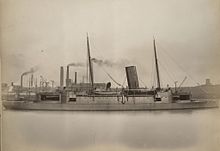Chinese cruiser Chaoyong

Chaoyong docked on the River Tyne
|
|
| History | |
|---|---|
|
|
|
| Name: | Chaoyong |
| Ordered: | 1879 |
| Builder: | Charles Mitchell & Company, Newcastle Upon Tyne, England |
| Laid down: | 15 January 1880 |
| Launched: | 11 November 1880 |
| Completed: | 14 July 1881 |
| Commissioned: | 22 November 1881 |
| Fate: | Sank, 17 September 1894 |
| General characteristics | |
| Class and type: | Tsukushi-class cruiser |
| Displacement: | 1,350 long tons (1,370 t) |
| Length: | 220 ft (67 m) |
| Beam: | 32 ft (9.8 m) |
| Draught: | 15.5 ft (4.7 m) |
| Installed power: | 2,580 ihp (1,920 kW) |
| Propulsion: |
|
| Speed: | 16 kn (30 km/h; 18 mph) |
| Boats & landing craft carried: |
2 x Pinnaces |
| Complement: | 140 |
| Armament: |
|
Chaoyong (Chinese: 超勇; pinyin: Chāoyǒng; Wade–Giles: Ch'ao-yung) was a cruiser built for the Imperial Chinese Navy. She was built by Charles Mitchell & Company in Newcastle Upon Tyne, England, from a design by Sir George Wightwick Rendel which had already been used on the Chilean Navy vessel Arturo Prat (later the Imperial Japanese Navy's Tsukushi). Two ships were ordered by the Chinese, Chaoyong and Yangwei. Both would serve together throughout their careers, assigned to the Beiyang Fleet and based in Taku during the summer, and Chemulpo, Korea, in the winter.
Chaoyong did not see any action during the Sino-French War, but in the First Sino-Japanese War, she was in the Chinese line at the Battle of Yalu River on 17 September 1894. She was one of the early casualties of the battle, being set alight, and sinking after a collision with the Chinese cruiser Jiyuan.
The design for Chaoyong was advertised by its designer, British naval architect Sir George Wightwick Rendel, as an example of a low-cost cruiser able to withstand larger ironclad warships. The design was later seen as an intermediate concept between his flat-iron gunboats and the protected cruiser. In theory, the ship would rely on its small size and higher speed, along with a higher muzzle velocity main battery to attack larger, less maneuverable ships.
...
Wikipedia
